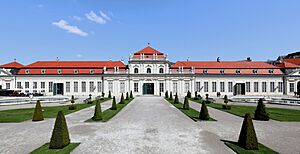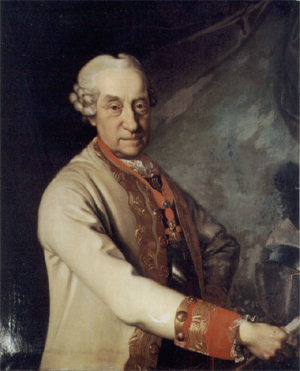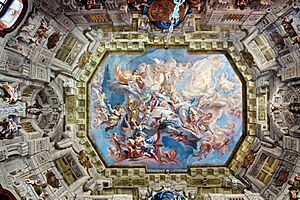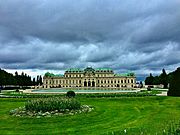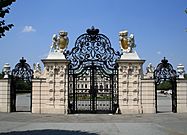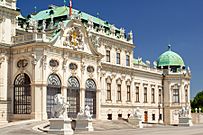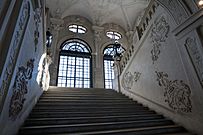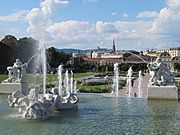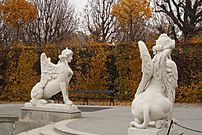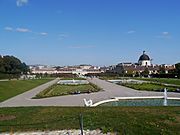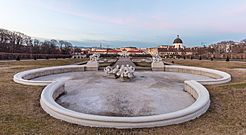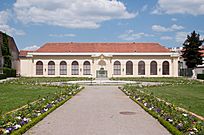Belvedere, Vienna facts for kids
Quick facts for kids Belvedere |
|
|---|---|
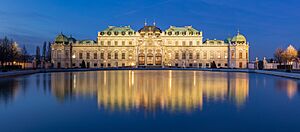
Upper Belvedere at night, 2020
|
|
| Location | Vienna, Austria |
| Built | 1723 |
| Built for | Prince Eugene of Savoy |
| Original use | Summer residence |
| Current use | Museum |
| Architect | Johann Lukas von Hildebrandt |
| Architectural style(s) | Baroque |
The Belvedere is a beautiful group of buildings in Vienna, Austria. It includes two grand palaces, called the Upper and Lower Belvedere. There's also an Orangery and stables. These buildings are surrounded by a lovely Baroque park.
Today, the Belvedere is a famous museum. It's known as the Österreichische Galerie Belvedere in German. The gardens have pretty fountains, waterfalls, and amazing sculptures. This whole palace complex was built a long time ago as a summer home for Prince Eugene of Savoy.
The Belvedere was built when Vienna was growing fast. It was the capital city and home to the powerful Habsburg family. This rich time came after Prince Eugene won many wars.
Contents
Lower Belvedere: A Prince's Dream Home
In 1697, Prince Eugene of Savoy bought a large piece of land. It was south of Vienna's main road to Hungary. He immediately started planning a garden and palace complex. The prince chose Johann Lukas von Hildebrandt as his main architect. Hildebrandt had already built other palaces for him.
Hildebrandt studied building in Rome. He became a court architect in Vienna in 1696. Besides the Belvedere, he designed many other important buildings. These include Schloss Hof and the Schwarzenberg Palace.
When Prince Eugene bought the land, it was empty. It was perfect for a big garden and summer palace. He bought more land in 1708, 1716, and 1717–18. This allowed him to make the garden even bigger.
Work on the Lower Belvedere began around 1712. It was finished quickly. Artists like Marcantonio Chiarini painted amazing ceiling art inside. The gardens were also designed at the same time. Dominique Girard, a famous garden designer from Versailles, helped create the beautiful layout.
Belvedere Gardens: A Royal Park
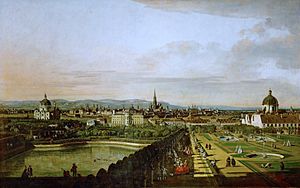
The Belvedere Gardens were designed in a formal French style. They have neatly trimmed hedges and gravel paths. Dominique Girard created them, just like the famous gardens at the Palace of Versailles. The sculptures in the gardens tell stories from old myths. They show Prince Eugene as a hero, like the god Apollo.
You can still see a large water basin and beautiful stairs today. These stairs have statues of nymphs and goddesses. They connect the upper and lower parts of the garden. A famous painting by Bernardo Bellotto shows a view of Vienna from the Belvedere. This view is still important when planning changes to the city today.
Upper Belvedere: A Grand Palace
Building the Upper Belvedere started around 1717. Prince Eugene wrote letters about how fast the work was going. By 1719, the palace was ready enough for him to host important guests. Artists like Francesco Solimena and Carlo Carlone painted beautiful frescoes inside.
The palace was finished in 1723. However, one room, the Sala Terrena, had problems. The architect Hildebrandt had to add strong pillars to support its ceiling. This gave the room its unique look today. The Upper Belvedere is so famous that it even appears on the 20-cent Austrian euro coins.
Belvedere After Prince Eugene
Prince Eugene died in 1736 without a clear will. His niece, Victoria, inherited the Belvedere. She didn't want the palace and tried to sell it. In 1752, Maria Theresa of Austria, the Empress, bought the estate.
The imperial family didn't live in the Belvedere. Maria Theresa used the Lower Belvedere to display portraits of her family. In 1770, a huge masked ball was held there. It celebrated the marriage of Princess Maria Antonia, who later became Marie Antoinette.
In 1776, Maria Theresa and her son, Emperor Joseph II, decided to open the imperial art collection to the public. They moved the paintings to the Upper Belvedere. It opened five years later, becoming one of the world's first public museums. The collection stayed there until 1891. Then it moved to the new Kunsthistorisches Museum.
While the Upper Belvedere was an art gallery, the Lower Belvedere housed royal family members. They were fleeing the French Revolution. Princess Marie Thérèse Charlotte, daughter of Marie Antoinette, lived there.
Later, in 1811, Emperor Francis II moved another important collection to the Lower Belvedere. This was the collection from Ambras Castle. It was too big for the palace, but it still attracted many visitors. The Lower Belvedere became a museum too.
Belvedere in Modern Times
After the imperial art collections moved, the Belvedere palaces were empty for a while. In 1896, Emperor Franz Joseph I made the Upper Belvedere a home for his nephew, Archduke Franz Ferdinand of Austria. Franz Ferdinand was the heir to the throne.
A few years later, in 1903, the Moderne Galerie opened in the Lower Belvedere. This was Austria's first state museum just for modern art. It showed Austrian art alongside international modern art. Famous artists like Vincent van Gogh and Claude Monet had works bought for this gallery. In 1911, it was renamed the k.u.k. Staatsgalerie and started showing art from earlier times too.
After World War I and the end of the Habsburg Monarchy in 1918, the Belvedere changed again. In 1919, the palaces became part of the state art gallery. New museums were created, including the Baroque Museum in the Lower Belvedere. The Moderne Galerie moved to the Orangery in 1929.

The palaces were badly damaged during World War II. Parts of the Marble Hall in the Upper Belvedere were destroyed. Restoration work took place from 1945 to 1953. In 1950, a big fire also damaged the Upper Belvedere. The museums reopened in 1953.
In 1996, the Belvedere Garden was added to a list of landmarks needing care. This was because some earlier repairs weren't perfect. Since then, the gardens have been restored to their original Baroque style. The palaces have also been renovated.
Today, the Lower Belvedere and the Orangery are used for special art exhibitions. Architects have updated these spaces while keeping their historic look. The main entrance to the Lower Belvedere was even moved back to its original spot. This allows visitors to see the beautiful view from the main gate all the way to the Upper Belvedere. The grand Baroque rooms, like the Marble Gallery, are still open for everyone to enjoy.
Gallery
See also
 In Spanish: Palacio Belvedere para niños
In Spanish: Palacio Belvedere para niños
- List of Baroque residences


